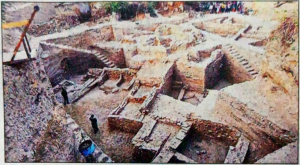Palaeochannel found by ASI being linked to the Saraswati
 JAIPUR — In a significant archaeological breakthrough, the Archaeological Survey of India (ASI) has discovered an ancient palaeochannel buried 23 metres deep in Bahaj village, Deeg district, Rajasthan. Many historians and archaeologists believe this could be part of the legendary Saraswati river mentioned in the Rig Veda.
JAIPUR — In a significant archaeological breakthrough, the Archaeological Survey of India (ASI) has discovered an ancient palaeochannel buried 23 metres deep in Bahaj village, Deeg district, Rajasthan. Many historians and archaeologists believe this could be part of the legendary Saraswati river mentioned in the Rig Veda.
The excavation, conducted between April 2024 and May 2025, has uncovered evidence of continuous human settlement from around 3500 to 1000 BC, with artefacts linked to the Kushan, Magadha, and Shunga dynasties.
Key finds include remains of residential structures, stratified trenches, furnaces, iron and copper tools, microlithic implements, and spiritual relics like 15 yajna kundas, votive tanks for Shakti worship, and terracotta idols of Shiva and Parvati.
Remarkably, four unbaked sealings were found, two bearing early Brahmi script — potentially the oldest datable Brahmi inscriptions discovered so far. Experts say this could reshape the understanding of ancient Indian coinage and writing systems.
According to Vinay Gupta, ASI Jaipur’s superintending archaeologist, the newly discovered river channel once sustained ancient communities and links Bahaj to the broader Saraswati civilisation.
The Ministry of Culture will soon decide preservation plans for the site, which also revealed evidence of advanced metallurgy, bone tool industries, beads, and shell bangles, highlighting Bahaj’s ancient craft traditions.
